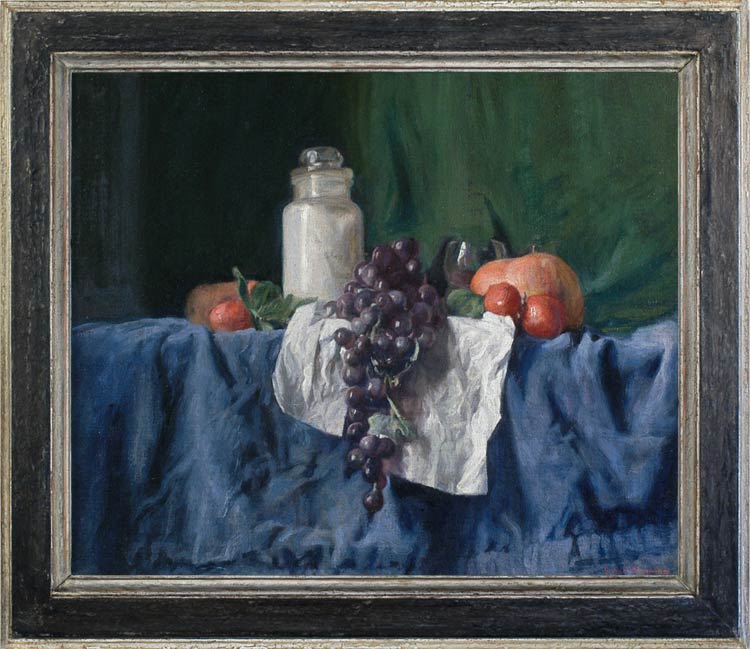The power of a glass jar to dominate a still life painting resides in the tension of the transparent container with the contents. Glasses of wine are common components of still life paintings, but a filled container is more challenging, as can be seen in Weissbort’s striking Arrangement with a loaf, a jar of red peppers & white linen on a shelf[q.v.]. Other artists who have used this motif include Miguel Parra (1784-1846), Still life with walnuts, olives in a glass jar, a partly-peeled lemon & a glass of wine, and the Hungarian Romek Arpad (1883-1960), many of whose compositions are based on arrangements of glass jars. Here Weissbort uses the strong white note of the jar of salt, together with a white napkin, to lift a still life built out of abstracted areas of dark, rich colour – lapis blue, bottle green, purple and soft red, Within this pattern, the different textures are set against each other – the soft pile of the fabric, the smooth gleam of fruit, the transparency of glass, and the powdery roughness of salt seen through the sheen of the glass.
Biographical details
George Weissbort (1928-2013) was born in Belgium and moved to London at the age of 7. He attended the Central School of Art & Design (now St Martin’s) where he was taught by Ruskin Spear and Rodrigo Moynihan. He was influenced by Arthur Segal to move from the abstract expressionism of the 1940s to realism, and by Bernard Meninsky, who taught life drawing at the Central School, to study the Old Masters. He turned first to artists such as Cézanne and Matisse, and later to Vermeer, Chardin, Velasquez, Corot, Titian, Holbein, and Piero della Francesca, amongst others.
He exhibited regularly at the Royal Academy, the Royal Society of Portrait Painters and the Fine Art Society. In 1964-65 he had a large exhibition in Paris, and in 2006 he had a one-man retrospective at the Chambers Gallery, London, followed in 2008 by another at the Denise Yapp Gallery, Whitebrook, Monmouth.
He wrote essays on art and criticism which look both at the techniques of making a painting, and of appreciating a work of art. The latter skill he believed came only after years of consciously training the eye to see as the artist saw, considering for example the ‘negative’ spaces around and between objects. He also discussed the work of specific artists, such as Lucien Freud and Vermeer.
His obituary in The Independent quotes Brian Sewell, a friend, as saying of him that Weissbort ‘painted the right pictures at the wrong time’. His appeal was to those who understood his models and influences; he could be described as a painter’s painter, and the same obituary quotes Paula Rego describing him as ‘a truly honest artist who knows so much about painting’.
Publications: George Weissbort, Paintings and Drawings (Parnassus, 2008), ill. 130 colour plates; includes transcripts of a filmed interview; essays by Tony Rudolph, David Lee and Bernard Dunstan RA.
YouTube video: A tribute to George Weissbort by John French.


